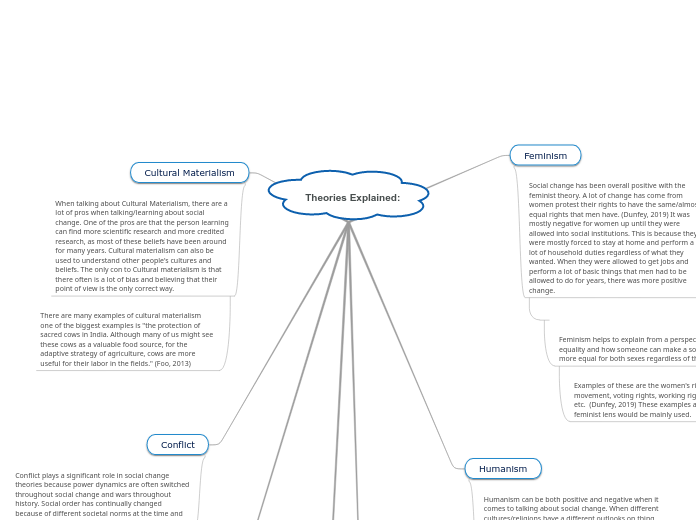Theories Explained:
Intersectionality
Intersectionality is one of the most viewed lenses when it comes to exploring different types of social change. It helps identify and explore different lives of people who are multifaceted. This theory also helps to further understand a person's social location, and how those factors can determine certian things like equality and equity.
Examples of Intersectionality can range a lot. It can pretty much be applied to any social justice movement. Examples of those are but not limited to "Black justice (which must acknowledge the unique challenges of Black trans women, for example) to climate change (ecofeminism acknowledges how Black, Indigenous, and other people of colour disproportionately suffer from environmental destruction) to gay rights" (Sullivan, 2020)
Cognitive
Cognitive theory can be used a lot when trying to explain different social conflicts because the cognitive theory is based off of simply peoples behaviours and by observing others. This can allow people to formulate their opinions based off of what they see from others. This can be very positive because people are allowed to accept or reject based off of what they see. This could also be bad because if people don't have enough exposer to others then their views may be limited.
Examples of the Cognitive theory would be things such as "someone may have learned altruistic behaviour from seeing parents bring food to a homeless person, or you may have learned how to train a dog from watching The Dog Whisperer."(Hurst, n.d.) There are many different examples of Cognitive theory in social events, but those are a few prominent examples.
Conflict
Conflict plays a significant role in social change theories because power dynamics are often switched throughout social change and wars throughout history. Social order has continually changed because of different societal norms at the time and what is socially acceptable and what is not.
Conflict helps us discover what we can do differently in history to help better the social change or prevent it entirely. Aspects like race, gender, and social class can either benefit these people or make conflicts worse in some circumstances.
Some examples of the Conflict theory being used to explain social change are the "global capitalism's effect on inequality and power. Pay inequalities between genders and races. The 2008 financial crisis, in which large companies and banks received government bailouts." (Indeed Editorial Team, 2021). There are also a lot more examples like war, and equality for both genders.
Cultural Materialism
When talking about Cultural Materialism, there are a lot of pros when talking/learning about social change. One of the pros are that the person learning can find more scientific research and more credited research, as most of these beliefs have been around for many years. Cultural materialism can also be used to understand other people's cultures and beliefs. The only con to Cultural materialism is that there often is a lot of bias and believing that their point of view is the only correct way.
There are many examples of cultural materialism one of the biggest examples is "the protection of sacred cows in India. Although many of us might see these cows as a valuable food source, for the adaptive strategy of agriculture, cows are more useful for their labor in the fields." (Foo, 2013)
Structural Functionalism
Structural functionalism helps evolution of thought as well as it helps to incorporate things that help the overall well beings of people
With social change structural functionalism plays a major role when trying to explain events of change. When parts of an integrated social system change, there is a tension between this and other parts of the system which is created. Sometimes when major (social) changes occur some of society may have a hard time adjusting and adapting their points of view.
Institutions like education are constantly changing and evolving to help convey messages of social change. In education there are history classes which focus on both the bad and good of social changes. They help to educate youth while still focusing on main messages of certain things that happened in the past, trying to be as unbiased as possible. Religion also is a big factor when it comes to talking about social changes, while religious views aren’t as evolving they help to talk about the past and let people formulate their own opinions of what happened in the past and who/what is responsible for it.
Humanism
Humanism can be both positive and negative when it comes to talking about social change. When different cultures/religions have a different outlooks on thing there can be clashes of differences, these can result in people forcing their own views upon others. While humanism allows people to choose their own qualities and outlooks this can lead to personalized ideas but limited as they are only viewing things from one perspective and not the broad perspective of other people's ideas.
Humanism allows personal perspective and people to form opinions, without the influence of other people.
Examples of religious humanism include Quakers, Lutherans, and Unitarian Universalists. (Very Well Mind, 2020) There is much more reason for using the Humanism lens to explain a social change.
Feminism
Social change has been overall positive with the feminist theory. A lot of change has come from women protest their rights to have the same/almost equal rights that men have. (Dunfey, 2019) It was mostly negative for women up until they were allowed into social institutions. This is because they were mostly forced to stay at home and perform a lot of household duties regardless of what they wanted. When they were allowed to get jobs and perform a lot of basic things that men had to be allowed to do for years, there was more positive change.









